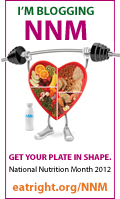March Is National Nutrition Month®
Before I was a dietitian, I was a cook. So my weapon of choice to promote National Nutrition Month® is a recipe. The theme for 2012, created and promoted by the Academy of Nutrition and Dietetics, is “Get Your Plate in Shape.” Here are some of my favorite recipes and tips to help bring a few of the theme’s key messages to (hopefully) appetizing life.
Make half your plate fruits and vegetables.
Fruit fits any time. Each morning I pack a 2-cup container of fresh cut fruit (5 or 6 types) for each person in the family to take to work, school or wherever. The fruit is eaten with a meal, as a snack or dessert. This insures we get a variety of fresh fruit daily and keeps us from straying to the cookie jar or vending machine.
For a change of pace, or to appease those picky about produce, make a smoothie. The latest trend in smoothies seems to be adding greens like spinach and kale– especially for people who resist eating dark green vegetables. Try A Rainbow of Smoothie Ideas.
As soon as my children had teeth (enough to safely chew and swallow), I served raw or lightly steamed vegetables, often with a dip, before dinner when they were at their hungriest and willing to sample new foods. Adults enjoy a time to relax and socialize over an appetizer platter of vegetables, too, before diving into dinner. Use a salsa or dip based on light dairy, mayo or other ingredients so you don’t spoil your appetite. Venture beyond Ranch and make Muhamarra Dip. Include dark green and orange-colored produce often. Here are ideas for cooking with popular kale.
Make at least half your grains whole.
There’s no excuse not to eat whole grains these days because there is such a tremendous variety available – from crunchy breakfast cereals, to pasta, English muffins, tortillas, pita breads, crackers and more. For side dishes look for fragrant brown basmati, brown jasmine and stunning black rice, to name a few. When time is short my favorites are whole wheat couscous and bulgur wheat. When you have a little more time try Ancient Grains Risotto.
Vary your protein choices.
Say the word “protein” and many people think meat. That’s OK as long as you opt for lean cuts to trim your intake of solid fats. Remember other high-protein foods, each with unique nutritional benefits, including eggs, nuts, beans and peas and seafood.
New to the Dietary Guidelines for Americans 2010 is the recommendation to include seafood twice a week to boost omega-3 fatty acids which may help prevent heart disease and improve infant health (when the mom consumes at least 8 ounces of seafood weekly). Research is exploring many other health benefits of these fats. Choices should be lower in methyl mercury of course.Need inspiration? Try Lime-Glazed Cod with Triple Pepper Tomato Sauce.
Beans and peas, highly economical, can be considered either a vegetable or protein food because they contain protein, other nutrients and fiber (exceptions are green peas and green beans which are vegetables). Here is one of my go-to pasta dishes with marinated chickpeas (garbanzo beans).
Switch to fat-free or low-fat milk.
Milk and milk products are significant sources of protein but they comprise a separate food group because they provide notable amounts of key nutrients such as calcium, potassium, magnesium, vitamin A and vitamin D (when fortified).
Ever since I lived in France, I’ve started my morning with a caffeine fix that fuels my bones at the same time – a big bowl filled half with warm fat-free milk and half strong coffee. Trying to get to sleep? My nightcap of choice is a mug of warm milk with a swirl of honey and a drop of pure vanilla.
If you resist fat-free or low-fat dairy, make the change gradually by mixing whole or 2% milk with gradually increasing amounts of fat-free or 1%. If you don’t like fluid milk, go for yogurt. Fat-free Greek yogurt is so rich and creamy you can use it like sour cream. Know that it generally has more protein but less calcium than regular yogurt.
Cheese is a nutrient-rich alternative with most of the nutrients of milk in a concentrated form. To trim the solid fat and calories tap into the growing selection of reduced- and low-fat cheeses. Some are remarkably tasty. See my Cheese blog for tips.
If you have lactose maldigestion go for lactose-free milk. Some people with the condition remain symptom-free consuming yogurt with live, active cultures and hard aged cheeses. Fortified soy beverages (added calcium, vitamin A and D) are an option too because they are similar nutritionally.
There are more “Get Your Plate in Shape” messages but I’ll start with these, closing this post with my favorite: Enjoy Your Food.*
*The phrase Enjoy Your Food is accompanied by “but eat less” in the “Get Your Plate in Shape” messages. This addresses people wishing to balance their caloric intake and exercise to achieve a healthier weight.
For more resources and information visit National Nutrition Month® .
Want More Personal Nutrition Information? Check out the SuperTracker, part of the USDA’s ChooseMyPlate website . Here you can create a personal profile to get recommendations for what and how much to eat, track your food intake, activity and weight, generate reports and more.
Copyright © Lorelle S Del Matto 2012

 About lorelle
About lorelle
Speak Your Mind